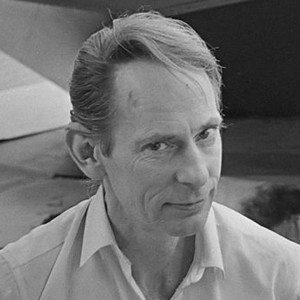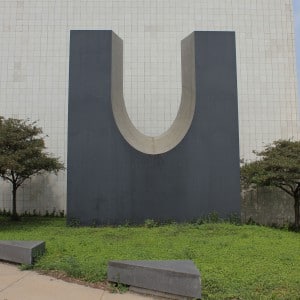Ronald Bladen
American artist Ronald Bladen (1918-88), often identified as one of the “fathers of Minimalism,” came late to sculpture. During the 1950’s and prior to his development as a sculptor, Bladen created a number of paintings that in manner and form were directly related to the work of the Abstract Expressionists.
His paintings – “gritty concretions protruding – sometimes as much as four inches – amid stucco or froth-like expanses” [Berkson, Bill. “Introduction,” Ronald Bladen: Early and Late, San Francisco Museum of Modern Art, 1991, p. 6] are strikingly different from the cool, reductivist sculpture to follow, but there does exist a soulful continuity throughout Bladen’s artistic production.
A full generation older than its key Minimalist figures, he advocated an art that could capture the sublime experience of natural phenomena, an attitude more in keeping with Abstract Expressionist aesthetics than Minimalist’s refusal of transcendental/mystical meaning.
Bladen said he was looking for “that area of excitement belonging to natural phenomena such as a gigantic wave poised before it makes its fall, or man-made phenomena such as the high bridge spanning two distant points.” Above all, he said, he wanted “presence.”
Bladen’s signature effect gives massive black forms an air of light, speed, and weightlessness. Sharp angles cut through the air, unzipping the space. Beams spread open. Geometric shapes intertwine but do not lock. “What I am after,” he also said, “is to create a drama out of a minimal experience.” [Stevens, Mark. “Maximal Minimalist,” New York Magazine, March 1, 1999, http://nymag.com/nymetro/arts/art/reviews/134/, accessed: March 31, 2009]
Bladen studied at Vancouver School of Art, British Columbia and California School of Fine Arts, San Francisco, and taught art at prestigious schools, including Yale University, CT and Parsons School of Design, NY. His sculptures have been exhibited and written about extensively. His works of art are found in major museum and corporate collections throughout the United States, such as: Boston Federal Reserve Bank, MS; The Metropolitan Museum of Art, NY; Social Security Building, Baltimore, MD; Lannan Foundation, Los Angeles, CA; San Francisco Museum of Modern Art, CA; and Fogg Art Museum, Cambridge, MS.

